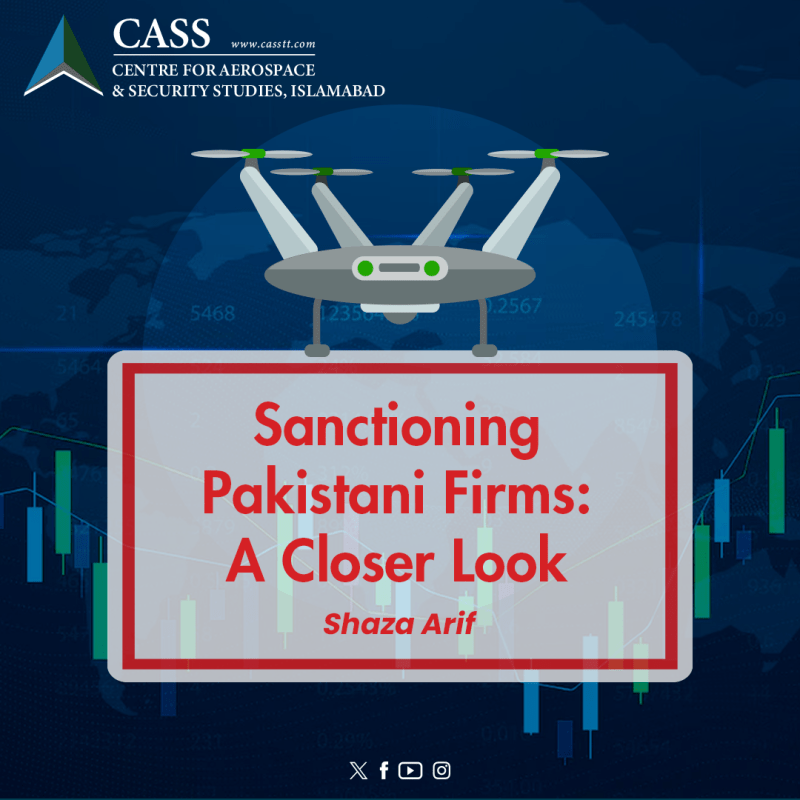In a recent move, the United States imposed sanctions on 26 firms based in Pakistan, Iran, and China. The blacklisted entities are alleged to be supporting weapons and drone development. 16 of these firms are based in Pakistan. Nine firms are suspected of acting as front companies and procurement agents for already-banned companies, whereas the remaining seven are suspected of supporting the missile development programme.
These recent sanctions have dominated headlines, sparking debates across the media. Although their immediate scope may seem limited, the real conversation lies beyond the surface. In today’s volatile geopolitical environment, sanctions represent more than just punitive measures – they test the resolve, alliances and economic resilience of both the sanctioned and the sanctioner.
The bigger question remains: Can state sanctions still serve as effective tools of influence in a world increasingly defined by interconnected economies and shifting power dynamics?
Sanctions have long served as a coercive tool in international relations, aiming to alter state behavior without resorting to direct conflict. The earliest recorded use dates back to 432 BC, when the Athenian Empire barred traders from Megara from its marketplaces. In the 20th Century, sanctions re-emerged as a formal strategy during and after the World Wars, evolving into a primary instrument of political pressure. The post-9/11 era added new layers of complexity, introducing targeted sanctions aimed at countering terrorism and preventing nuclear proliferation. Pakistan, among other nations, has faced periodic sanctions, reflecting the changing dynamics of global politics.
Historically, the effectiveness of sanctions hinges on the strength of the underlying motivation and alignment of strategic objectives. While sanctions can influence behaviour, their impact tends to remain subtle unless accompanied by robust diplomatic efforts and clear goals. A review of US sanctions since 1970 reveals that they have successfully altered the targeted countries’ behaviour only 13 percent of the time. This limited effectiveness can be attributed to several factors.
Technological denials spur indigenisation and innovation due to self-reliance, reducing dependency on external sources. In this context, local Research and Development (R&D) can lead to significant breakthroughs to lessen the impact of sanctions over time. Sanctions often accelerate the diversification of supply chains, prompting targeted countries to seek alternative partners for technology and resources. This strategic shift reduces the sanctions’ overall impact by limiting the enforcing countries’ leverage.
Sanctions often also foster bloc politics, encouraging countries to collaborate in sharing technology and expertise. Then there are always opportunities to employ evasion tactics to bypass sanctions, including moving towards commercial channels. Hence, rapid pace of technological advancement and its widespread proliferation in contemporary times further diminishes the effectiveness of sanctions, as access to alternatives becomes increasingly feasible.
One also cannot ignore the fact that technological advancements have become globalised and the monopoly over cross-cutting technology is steadily being eroded. States such as China, South Korea, and Japan have emerged as alternatives to attain critical components and systems. This shift allows states to source advanced technology from other potential suppliers. Moreover, the private sector worldwide is contributing extensively to dual-use technologies. This surge has led to the creation of platforms that can meet potential requirements. In addition, private entities and companies outside the concerned jurisdiction are not compelled to adhere to potential bans. Lastly, blacklisted companies can relocate, rename or continue their operations through intermediaries.
In several instances, states have successfully mitigated the impact of imposed sanctions. Pakistan’s experience with the Pressler Amendment serves as a notable example. Despite the US imposing sanctions in 1990, suspending military and economic aid, Pakistan managed to sustain its defence capabilities by diversifying partnerships and pursuing indigenous military development. Notably, Pakistan was barred from getting 38 F-16s for which agreements had been finalised and payments had been released. Faced with such restrictions, Pakistan adopted innovative strategies to mitigate the impact and fulfill its operational needs. The recovery and upgrade of existing aircraft allowed the Air Force to address immediate short-term requirements. Commercial channels were also utilised to procure essential spare parts, ensuring operational continuity. Meanwhile, innovative training programmes were introduced, enhancing the skills, tactics, and agility of personnel, further strengthening Pakistan’s defence capabilities despite external constraints. During this time, Pakistan also increased its collaboration with China which led to expansion of mega projects.
Likewise, more recently, Russia has continued to solicit and augment its military equipment despite Western sanctions. It has leveraged indigenous technology, resorted to commercial sources and strengthened partnerships outside the US-led alliance to overcome economic, military, and technological curbs. China has made considerable advancements in semiconductor technology by using workarounds and strengthening its own industry, mitigating the impact of American trade restrictions. Similarly, sanctions on Iran have failed to achieve their intended outcomes, resulting instead in military modernisation despite technological restrictions. Iran has developed indigenous capabilities in missile technology, drones, and defence systems, demonstrating remarkable adaptability under sanctions. These examples highlight how targeted nations can innovate and circumvent external pressures, countering the intended impact of imposed sanctions.
The contemporary era highlights the limits of coercive influence, revealing a growing capacity among states and firms to adapt and innovate. In an increasingly globalised world, sanctions are facing challenges to their effectiveness, as targeted entities find ways to circumvent restrictions. While banning specific firms may cause temporary disruption, it seldom halts technological advancement. Instead, affected states and firms overcome these barriers through diverse strategies. Consequently, they strengthen the very resolve that they aim to weaken.
Shaza Arif is a Research Associate at the Centre for Aerospace & Security Studies (CASS), Islamabad. The article was first published in The News International. She can be reached at [email protected].





